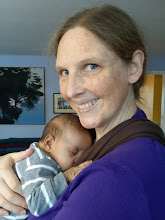Buses: the good, the bad, and the ugly
Public buses are the lifeblood of the greater San José metropolitan area, feeding workers and students from the outlying areas into the city center in the morning and back out at twilight. You can get almost anywhere in the area for under a dollar, but you have to learn the system. I dedicated myself to learning the major routes last week so that I would have some idea of how to get to work and back. Indeed, I was in one of these buses going from Tibas to Santo Domingo last week when the earthquake struck and I didn’t feel it. It seems a telling mark of the quality of the bus, and the quality of the roads, that a 6.2 magnitude quake did not feel like anything out of the ordinary.
Buses vary greatly in quality. Occasionally, especially for the longer hauls, one gets a bus with seats that approach comfortable, sometimes even with leg room. Some of the runs—Heredia-San José, San José-Alajuela—tend to have more modern coaches, and the drivers occasionally turn on a decent radio station, and you can enjoy the city going past with a nice salsa soundtrack and be thankful you are not among the honking hordes trying to force their way across three lanes of traffic. At the rock bottom of the bus quality scale, unfortunately, is the Universidad de Costa Rica bus I ride to work every day. There are a number of different buses that drive this route, all painted 1970’s wallpaper colors (so at least they are easy to spot and flag down), and they are all schoolbuses of uncertain vintage, of the sort I used to ride to high school, but with about 30 more rows of seats than I ever remember in a high school bus. The consequence, of course, is that there is about 3 inches of space between each seat and the one in front of it, and for someone of my stature there is no conceivable way to get my legs into that space. Of course, most days I don’t get a seat anyway—the bus fills up in Heredia, and by the time it gets to my stop it is SRO. Barely. This morning I ended up in the rear stairwell of the bus, holding on for dear life. Generally I end up jouncing along, crammed in with the other hapless aisle passengers hanging for dear life to a bar bolted to the ceiling, and ducking for speed bumps (lesson learned the hard way). And the soundtrack in the UCR bus is pretty horrendous, too—the grinding of gears, the straining of the poor motor as it wheezes up one last hill, and for some unaccountable reason, the CB radio chatter between the drivers on the route played at ear-splitting volume on the staticky speakers. If I had been anywhere near the driver I would have asked him to turn it down, but I was stuck in among the sardines in the back.
The design of streets and intersections here continues to boggle my mind. There is a semi-major thoroughfare between San Pablo and Santo Domingo that still has a one-way bridge over the creek at the bottom. People stop and yield and honk ceaselessly, as though honking will somehow magically summon a more logical and smooth-flowing traffic pattern. The most astounding of intersections is one somewhere in Moravia or Guadalupe, one of the towns that the UCR bus travels through in its loop around the city. It’s four roads meeting in a cross-shaped intersection, but the middle road is a jam-packed, two-lane, one-way street. The other two roads, feeding into it from opposite directions, are also two-lane, one-way streets, also jam-packed at rush hour. All without the benefit of any traffic signals except for the manifestly ignored stop signs at the corners of the incoming roads. The grand strategy is to honk loudly and force your vehicle into whatever gap appears. No matter how shoddy the bus, I am always glad I don’t have to drive through there!
There is an odd sort of fatalism in the way people put up with things here. The crazy intersections, the horrible bus radio, accidents, the weather. I’ve seen people walk down the street getting soaking wet in a rain shower, carrying umbrellas in their bags. It’s as though people put their fate in the hands of a higher power, and therefore don’t really do anything to try to change it. A couple of nights ago I was in a Tibas-Santo Domingo bus, jammed in at the very front by the driver, and I noticed a large sticker on the rear view mirror: Jesus guia mi camino. Jesus guides my path. Nice sentiment, but on the rearview mirror?
Well, I don’t want to come across as one of those embittered US expatriates who lives in Costa Rica and spends all her time complaining about how backward it is here. In some ways, it’s a more forward-looking country than the US. As much as I gripe about the UCR buses, it’s pretty wonderful to be able to get anywhere I need to for under a dollar, and often faster than by car—especially in the downtown area, the designated bus lanes still move when everything else is gridlocked. I don’t know of anywhere in the US with such a cheap, efficient, and effective transportation system. Something for our new president to work on!

















